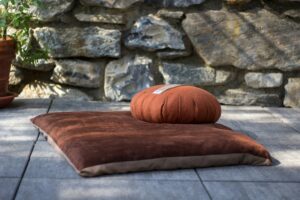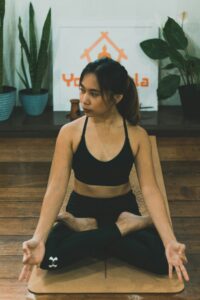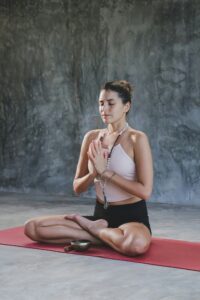Have you ever seen pictures of people meditating and thought ‘I can’t sit like THAT!’
Is it necessary to sit a certain way to be able to meditate? Do your legs need to be tangled like a pretzel?
Is there a best posture for meditation?
The skills of mindfulness meditation are attentional. In other words they’re about paying attention. Really concentrating is intrinsically calming so a relaxed posture is appropriate in support of the ease that focus creates. Paying attention also requires alterness so an ideal posture should support both alterness and relaxation. If our posture is well balanced our bodies can be relaxed while we remain alert.
What Is The Best Posture for Meditation?
Meditators over the millenia have adopted various postures according to the traditions within which they practise. The reasons these postures exist may vary but fundamentally they are to create a well-balanced, stable basis for long periods of meditation.
Lotus Pose Half Lotus Pose

Zafu on a Zabuton
In Lotus or Half Lotus many people will use a round cushion called a zafu, which is placed on a thick padded mat called a Zabuton. You could also use a firm cushion and a folded blanket as your ‘mat’.
These postures require very flexible hip flexors in order to not cause damage to the knees. A monastic life devoted to hours of contemplative practice each day would likely condition one’s body to become comfortable with these postures over time. For non-monastics a random ‘how to do the full lotus’ search on YouTube will offer you a range of tutorials wisely stressing the need to gradually develop the appropriate flexibility to do these postures safely.
Taking a ‘no-damage’ approach is important. We want to be able to practise meditation for the rest of our lives if we choose. Ultimately we are here developing attention skills and the posture and equipment we choose should support that priority. If we wish to take a more accessible route a simple approach to posture is available and completely viable for meditation.
You could:
-
Sit Cross-Legged
The posture of pre-schoolers everywhere. You may like to experiment with cushions to find a comfortable position that supports you well)
-
Sit On A Chair
There is nothing wrong with sitting on a chair if your posture allows you to be balanced to maintain alertness and relaxation
-
Seiza Style
Kneeling with your feet tucked under your bottom. You could do this sitting on a cushion, several cushions or a meditation bench
However you choose to set yourself up for meditation, always remember to maintain good posture. Keep in mind you want a long spine, relaxed jaw with your shoulders relaxed and back. Place your hands wherever they feel comfortable for you. Your posture should support you and promote alertness and relaxation to help you as you practise developing the attention skills of mindfulness.
We have focused on how good posture supports meditation when a meditator is sitting still in one place. Meditating in stillness is one way to meditate. It has its own distinct advantages. A quiet space, on our own can help us focus on more subtle aspects of our experience. We’re competing with less than we might be in a noisy public place. What if we wanted to be able to meditate in that noisy space? What if we wanted to meditate anywhere, anytime and how would we support that with a ‘no damage approach’.
Ways To Approach Daily Meditation Practice
The Unified Mindfulness System has a unique and very helpful way of approaching this.
They divide formal and informal practice with clear definitions.
Formal practice
- 10 minutes or more practice
- given your full attention
Formal practice be done in Stillness or in Motion
Informal Practice (is either):
- less than 10 minutes of practice or
- a practice where less than your full attention is on the practice while you are mostly focused on whatever else you are doing
Informal practice be done in Stillness or in Motion
The Unified Mindfulness System has some unique ways to approach the informal practice ideas represented in the dot points listed. Learn more about them in How To Meditate When You Have No Time For Meditation.
A ‘No-Damage Approach’
Formal Practice In Motion
Formal Practice in Motion means you are focusing strongly on your practice while engaged in some movement or activity other than sitting on your own. You could be at the gym on an exercise bike or a treadmill. You could also be walking, riding, driving, washing dishes or gardening. The possibilities are fairly endless. It is important to consider that if you are engaged in a formal practice then almost all your attention is focused on that practice. If you are also involved in moving around in the world then some consideration needs to be given to yours (and others) safety.
To support this you could:
- choose to engage in activity which is low risk (riding an exercise bike)
- choose a practice that focuses on the environment around you
Choosing a practice that allows you to really focus on your environment helps to be more aware of potential hazards. When we practice in this way we are likely paying more attention than when we’re typically driving, walking, riding. However, it is still important to be ready to let go of practice momentarily when we need to concentrate on reacting to traffic, changing lanes etc. Any task that requires our focus for safety is obviously important. This kind of approach to formal practice will require us toggling between being aware of what is around us (our practice) and reacting to it appropriately.
Walking Meditation
Many meditative traditions include a version of walking meditation. Commonly this is done slowly with sustained concentration on the physical actions involved in moving our bodies slowly as we walk. If you are in a crowded city street moving extremely slowly could create its own kind of hazards.
Alternatively you could:
- choose to do a walking meditation at more normal pace but instead focus again on aspects of your external experience
- bring your attention to the feeling of your body moving but just at this faster pace
- learn a Unified Mindfulness Technique that focuses on the quality of automaticity in your movements. In these practices our your attention is focused on noticing the way an aspect of our experience (in this case walking) is ‘just happening’ without our consciously directing it. Learn more about this technique at one of our Aussie Meditation Courses.
Informal Practice
Informal Practice makes meditation practice REALLY accessible and adaptable. If the only approach we consider ‘valid’ is formal meditation practice in a isolated space then we may not even start. Many of us feel time poor. Adding yet another activity to our busy-ness might get a hard NO! With some mindfulness instruction we can learn how to practice without adding extra time into our crowded diaries for meditation.
Background Practice
One option for informal practice is to use a small portion of attention to keeping a technique of your choice happening ‘in the background’ (Background Practice in Unified Mindfulness). This allows you to give whatever task you are doing the attention it requires. This has the added benefit of allowing us to being able to engage in an activity with some potential risk and to practice at the same time. Instead of toggling between the two you can keep practice happening gently in the background with a minimum of attention.
Any example of a background practice could be focusing on creating or finding REST (relaxation) in your body. This is called the FEEL REST technique in Unified Mindfulness. Keeping a background focus on relaxation, especially when we’re busy, can go a huge way to helping us keep a level of ease and calm in challenging environments. At the end of the day we’re much less exhausted than when we approach the day with a ‘just push through’ attitude. In its own way this kind of practice is adding a ‘no damage’ approach gently to our daily activities.
TIP: Before you practice any technique as background practice spend some time practicing it as a formal practice to get a good sense of it first. You can try various techniques as guided meditations HERE.
Microhits
As mentioned earlier another option from the Unified Mindfulness System for informal practice is to give a technique your full attention for a short period (anything less than 10 minutes). This could be done in stillness (think toilet breaks) or in motion (short walks). Once again choosing to focus on aspects of the environment or choosing a safe activity is wise when we’re in motion and focusing strongly on our practice. The value of these short bursts can’t be overstated. In Unified Mindfulness they are called ‘Microhits’.
If we take a quality over quantity approach and bring as much focus as possible to a short period of practice it can help an enormous impact on how we’re feeling. What we’ve been carrying from the events of the day for example can, even in a short period of highly focused practice, be encouraged to dissipate with a practice that ‘deconstructs’ our inner experience. Learn more about this Mindfulness strategy in What is Mindfulness or The Skills of Mindfulness – Sensory Clarity.
Related Questions
Is sitting down better than lying down for meditation?
Practicing and maintaining the balanced between alertness and relaxation may be more challenging lying down. It’s not impossible though. Knowing that you are practicing attention skills and bringing a clear intention to doing so while lying down may help us from drifting into slumber. If you are struggling..maybe enjoy a good sleep if you need it and return to practice later.
Where can I get a meditation bench?
Meditation benches, zafu and zabuton are available via a quick online search.
Experience a range of Meditation Techniques and Strategies that you can practice anywhere, anytime.
Join one of our Courses or take Mindfulness and apply it directly to your goals and happiness with 1 to 1 Coaching

